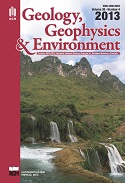Application of pattern recognition methods to automatic identification of microscopic images of rocks registered under different polarization and lighting conditions
DOI:
https://doi.org/10.7494/geol.2013.39.4.373Keywords:
pattern recognition, automatic rock classification, image processingAbstract
The paper presents the results of the automatic classification of rock images, taken under an optical microscope under different lighting conditions and with different polarization angles. The classification was conducted with the use of four pattern recognition methods: nearest neighbor, k-nearest neighbors, nearest mode, and optimal spherical neighborhoods on thin sections of five selected rocks. During research the CIELAB color space and the 9D feature space were used. The results indicate that changing both lighting conditions and polarization angles results in worsening the classification outcome, although not substantially. Duduring the automatic classification of rocks photographed under different lighting and polarization conditions, the highest number of correctly classified rocks (97%) is given by the nearest neighbor method. The results show that the automatic classification of rocks is possible within a pre-defined group of rocks. The results also indicate the optimal spherical neighborhoods method to be the safest method out of those tested, which means that it returns the lowest number of incorrect classifications.Downloads
References
Bianconi F., Gonzalez E., Fernandez A. & Saetta A.S., 2012. Automatic classification of granite tiles through colour and texture features. Expert Systems with Applications, 39, 12, 11212-11218.
Cabello E., Sanchez A.M. & Delgadoz J., 2002. A new approach to identify big rocks with applications to the mining industry. Real-Time Imaging, 8, 1, 1-9.
Dunlop H., 2006. Automatic rock detection and classification in natural scenes. Carnegie Mellon University, Robotics Institute, Pittsburgh [M.Sc. thesis].
Dzwinel K., Haber A. & Krawiec D., 2006. Zastosowanie samoorganizujących sieci neuronowych Kohoena w klasyfikacji sejsmofacjalnej (rejon Ujkowice - Batycze). Geologia. Kwartalnik Akademii Górniczo-Hutniczej im. Stanisława Staszica w Krakowie, 32, 4, 441-450.
Jarzyna J., Opyrchał A. & Mozgowoj D., 2007. Sztuczne sieci neuronowe dla uzupełnienia danych w geofizyce otworowej - wybrane przykłady. Geologia. Kwartalnik Akademii Górniczo-Hutniczej im. Stanisława Staszica w Krakowie, 33, 4/1, 81-102.
Marmo R., Amodio S., Tagliaferri R., Ferreri V. & Longo G., 2005. Textural identification of carbonate rocks by image processing and neural network: Methodology proposal and examples. Computers & Geosciences, 31, 649-659.
Marshallinger R., 1997. Automatic mineral classification in the macroscopic scale. Computers & Geosciences, 23, 119-126.
Mastej W., 2011. Próba wykorzystania sieci neuronowych w kompleksowej interpretacji danych elektromagnetycznych na przykładzie złoża Grabownica. Geologia. Kwartalnik Akademii Górniczo-Hutniczej im. Stanisława Staszica w Krakowie, 37, 1, 157-173.
Messina A. & Langer H., 2011. Pattern recognition of volcanic tremor data on Mt. Etna (Italy) with KK Analysis - A software program for unsupervised classification. Computers & Geosciences, 37, 953-961.
Młynarczuk M., 2010. Description and classification of rock surfaces by means of laser profilometry. International Journal of Rock Mechanics & Mining Sciences, 47', 138-149.
Młynarczuk M., Górszczyk A. & Ślipek B., 2013. The application of pattern recognition in the automatic classification of microscopic rock images. Computers & Geosciences, 60, 126-133.
Mougiakakou S.G., Tsouchlaraki A.T., Cassios C., Nikita K.S., Matsopoulos G.K. & Uzunoglu N.K., 2005. SCAPEVTEWER: Preliminary results of a landscape perception classification system based on neural network technology. Ecological Engineering, 24, 5-15.
Obara B., 2007. Identification of transcrystalline microcracks observed in microscope images of a dolomite structure using image analysis methods based on linear structuring element processing. Computers & Geosciences, 33, 151-158.
Ślipek B., Mazurkiewicz Ł. & Oleszko K., 2012. Możliwość wykorzystania metod rozpoznawania obrazów do zastosowań geologicznych na przykładzie automatycznej klasyfikacji zdjęć odsłonięć skalnych. Młodzi naukowcy dla polskiej nauki: materiały Konferencji Młodych Naukowców nt. Wpływ młodych naukowców na osiągnięcia polskiej nauki - Nowe trendy w naukach przyrodniczych, III edycja. Kraków 16.12.2012 r., Creativetime, Kraków.
Tadeusiewicz R. & Flasiński M., 1991. Rozpoznawanie obrazów. Państwowe Wydawnictwo Naukowe, Warszawa.
Downloads
Published
Issue
Section
License
Authors have full copyright and property rights to their work. Their copyrights to store the work, duplicate it in printing (as well as in the form of a digital CD recording), to make it available in the digital form, on the Internet and putting into circulation multiplied copies of the work worldwide are unlimited.
The content of the journal is freely available according to the Creative Commons License Attribution 4.0 International (CC BY 4.0)










